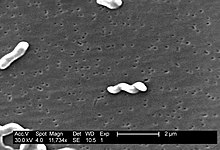Campylobacter jejuni
| Campylobacter jejuni | |
|---|---|

| |
| Scanning electron micrograph of C. jejuni demonstrating the characteristic curve rod shape of the organism | |
| Scientific classification | |
| Domain: | |
| Phylum: | |
| Class: | Epsilon Proteobacteria
|
| Order: | |
| Family: | |
| Genus: | |
| Species: | C. jejuni
|
| Binomial name | |
| Campylobacter jejuni (Jones et al. 1931)
Veron & Chatelain 1973 | |

Campylobacter jejuni is a species of bacterium commonly found in animal feces. It is curved, helical-shaped, non-spore forming, Gram-negative, and microaerophilic.[1][2][3] This species of pathogenic bacteria is one of the most common causes of human gastroenteritis in the world. Food poisoning caused by Campylobacter species can be severely debilitating, but is rarely life-threatening. It has been linked with subsequent development of Guillain–Barré syndrome (GBS), which usually develops two to three weeks after the initial illness.[4]
Sources
C. jejuni is commonly associated with poultry, and it naturally colonises the digestive tract of many bird species. One study found that 30% of European starlings in farm settings in Oxfordshire, United Kingdom, were carriers of C. jejuni.[5] It is also common in cattle, and although it is normally a harmless commensal of the gastrointestinal tract in these animals, it can cause campylobacteriosis in calves. It has also been isolated from wombat and kangaroo feces, being a cause of bushwalkers' diarrhea. Contaminated drinking water and unpasteurized milk provide an efficient means for distribution. Contaminated food is a major source of isolated infections, with incorrectly prepared meat and poultry as the primary source of the bacteria.
Genome
The genome of C. jejuni strain NCTC11168 was published in 2000, revealing 1,641,481 base pairs (30.6% G+C) predicted to encode 1,654 proteins and 54 stable RNA species. The genome is unusual in that there are virtually no insertion sequences or phage-associated sequences and very few repeat sequences. One of the most striking findings in the genome was the presence of hypervariable sequences. These short homopolymeric runs of nucleotides were commonly found in genes encoding the biosynthesis or modification of surface structures, or in closely linked genes of unknown function. The apparently high rate of variation of these homopolymeric tracts may be important in the survival strategy of C. jejuni.[6]
Initial transposon mutagenesis screens revealed 195 essential genes, although this number is likely to go up with additional analysis.[7]
Disease
Infection with C. jejuni usually results in enteritis, which is characterised by abdominal pain, diarrhea, fever, and malaise. The symptoms usually persist for between 24 hours and a week, but may be longer. Diarrhea can vary in severity from loose stools to bloody stools. The disease is usually self-limiting. However, it does respond to antibiotics. Severe (accompanying fevers, blood in stools) or prolonged cases may require erythromycin, azithromycin, ciprofloxacin, or norfloxacin. Fluid and electrolyte replacement may be required for serious cases.
Laboratory characteristics
| Characteristic | Result |
|---|---|
| Growth at 25 °C | − |
| Growth at 35–37 °C | + |
| Growth at 42 °C | + |
| Nitrate reduction | + |
| Catalase test | + |
| Oxidase test | + |
| Growth on MacConkey agar | + |
| Motility (wet mount) | + |
| Glucose utilization | − |
| Hippurate hydrolysis | + |
| Resistance to nalidixic acid | − |
| Resistance to cephalothin | + |

Under light microscopy, C. jejuni has a characteristic "sea-gull" shape as a consequence of its helical form. Campylobacter is grown on specially selective "CAMP" agar plates at 42°C, the normal avian body temperature, rather than at 37°C, the temperature at which most other pathogenic bacteria are grown. Since the colonies are oxidase positive, they will usually only grow in scanty amounts on the plates. Microaerophilic conditions are required for luxurious growth. A selective blood agar medium (Skirrow's medium) can be used. Greater selectivity can be gained with an infusion of a cocktail of antibiotics: vancomycin, polymixin-B, trimethoprim and actidione ([Preston's agar]),[8] and growth under microaerophilic conditions at 42°C.
See also
References
- ^ Ryan KJ, Ray CG (editors) (2004). Sherris Medical Microbiology (4th ed.). McGraw Hill. ISBN 0-8385-8529-9.
{{cite book}}:|author=has generic name (help) - ^ Online Bacteriological Analytical Manual, Chapter 7: Campylobacter
- ^ Gorbach, Sherwood L., Falagas, Matthew (editors) (2001). The 5 minute infectious diseases consult (1st ed.). Lippincott Williams & Wilkins. ISBN 0-683-30736-3.
{{cite book}}:|author=has generic name (help)CS1 maint: multiple names: authors list (link)"Multiple Campylobacter Genomes Sequenced". 2005-01-04. Retrieved 2007-07-27. - ^ Fujimoto S, Amako K. Guillain-Barre syndrome and Campylobacter jejuni infection. Lancet 1990;35:1350.
- ^ F M Colles, N D McCarthy, J C Howe, C L Devereux, A G Gosler, and M C J Maiden Dynamics of Campylobacter colonization of a natural host, Sturnus vulgaris (European Starling) Environ Microbiol. 2009 January; 11(1): 258–267. doi:10.1111/j.1462-2920.2008.01773.x.
- ^ Parkhill, J.; Wren, B. W.; Mungall, K.; Ketley, J. M.; Churcher, C.; Basham, D.; Chillingworth, T.; Davies, R. M.; Feltwell, T.; Holroyd, S.; Jagels, K.; Karlyshev, A. V.; Moule, S.; Pallen, M. J.; Penn, C. W.; Quail, M. A.; Rajandream, M. A.; Rutherford, K. M.; Van Vliet, A. H. M.; Whitehead, S.; Barrell, B. G. (2000). "The genome sequence of the food-borne pathogen Campylobacter jejuni reveals hypervariable sequences". Nature. 403 (6770): 665–8. doi:10.1038/35001088. PMID 10688204.
- ^ Stahl, M; Stintzi, A (2011). "Identification of essential genes in C. Jejuni genome highlights hyper-variable plasticity regions". Functional & Integrative Genomics. 11 (2): 241–57. doi:10.1007/s10142-011-0214-7. PMID 21344305.
- ^ "A selective medium for isolating Campylobacter jejuni/coli" (pdf). J Clin Pathol. 35: 462–476. 1982.
{{cite journal}}: Cite uses deprecated parameter|authors=(help)
External links
- Campylobacter jejuni genomes and related information at PATRIC, a Bioinformatics Resource Center funded by NIAID
- Current research on Campylobacter jejuni at the Norwich Research Park
